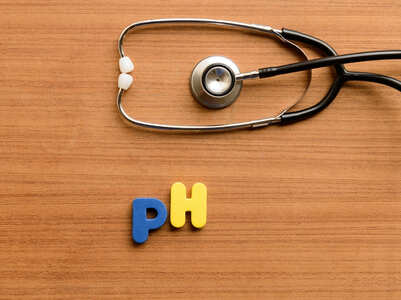Everything you need to know about skin pH and the myths around the same
Skincare treatments that will trend in 2021
Let your boss know who's the real boss! #FullOnSpeedy Samsung Galaxy F62 powered by flagship 7nm Exynos 9825 and 7000mAh FTW
Ananya Panday's Instagram is a place worth taking beauty inspiration from
Korean beauty expert recommended skincare routines for dry, oily and acne-prone skin
Everything you need to know about skin pH and the myths around the same
Everything you need to know about skin pH and the myths around the same

If you're someone who is inclined a lot towards taking good care of your skin, you might know several things about it. But when it comes to your skin, there's quite some amount of knowledge that the Internet may or may not always provide you with. And if you specifically talk about your skin's pH levels and the common myths around the same, you might find yourself lacking the knowledge on it. Hence, we got in a conversation with
Dr. Vibhav R Sanzgiri, Global Vice President R&D Skin Cleansing, Site Leader R&D India (Unilever) & Executive Director, HUL along with
Dr. Ananth KP, Professor and Academic Director of Cosmetic Science Programs, College of Pharmacy, University of Cincinnati, Ohio to talk about everything regarding skin pH. Here are some things that will definitely interest you about the same.
To begin with, you must first understand what skin pH really is. Dr Sanzgiri explained in detail saying, "Your skin pH varies typically between the numbers 4 and 6. The skin pH is something that isn't a fixed number and it gets affected both by external and internal factors. Internal factors being ethnicity, age or the conditions that you might have, all of which can affect your pH. External factors like climate, even day and night can be the reason." Did you know that your skin pH undergoes a diagonal cycle where it changes in the day as well as the night? "It's even different in different parts of your body. Your sweat, sebum and oil also have an impact on the variability of the skin's pH, said Dr. Sanzgiri.
We next moved on to know how to tell if your skin's pH is healthy or not. Dr. Sanzgiri explained it by saying, "There are instruments that can measure your skin pH. But, the skin pH alone is not a measure to tell you how healthy your skin is. To understand if your skin is healthy, you can use visual indicators, like if your skin is visually dry or healthy. If there's suppleness and elasticity to your skin or if there's moisture loss in your skin. All these things are measures of how healthy your skin really is. Hence, you must understand that just because your skin's pH is a certain number, it doesn't mean your skin is healthy."
We went on to understand if there's a standard limit on the usage of pH for skin? Dr. Ananth and Dr. Sanzgiri contributed and explained, "In India, if you're making a cleanser, like a soap bar, for example, we have to follow the Bureau of Indian Standards guidelines. It tells you very specifically what should be the amount of fatty matter, oil or alkali that you need to use in soap. So basically, when you combine the oil with an alkali, you generate soap. There is a standard that says that you need to have at least 60-78% of oil, a certain amount of alkali and then there are parameters of everything else that you can use. But, interestingly, there are no pH standards. So, the Bureau of Indian Standards says that the national standard for calling a product as soap does not have any pH specifications at all. It has specifications of the composition of the product." Dr. Ananth specified, pH is not the way you measure if the product is mild or not. If you use the wrong ingredients or surfactants, at a lower pH, it'll only damage your skin more than at a neutral or higher pH. And that is how you need to understand what makes a well-designed soap. That's the reason why these standards are designed the way they are.
Further, we wanted to know how we can restore the skin pH levels naturally. To this, the doctors made clear that your skin's health is a reflection of your personal health. Therefore, taking care of yourself in term of the right exercise, diet, etc. are absolutely important to keep your skin healthy. Secondly, you must use the right products that are well designed for your skin type. If you have medically compromised skin that leads to a compromised pH, then you must consult a dermatologist as they are the best to advise you how the pH levels can be restored.
What pH levels are harmful to skin was our next question. Dr. Sanzgiri mentioned, "You need to understand the segregation of your skin pH itself and the pH of the product that you apply to your body. There's something fundamentally wrong with your skin and as a consequence of that, your skin pH internally becomes more acidic or more alkaline. It can happen with certain kinds of diseases too. Under those conditions, it's obviously not good for your skin because that's where your skin has lost its buffering capacity. Your skin has lost its ability to regulate itself, and this is in case of the diseased condition." He further went on to explain, "If your skin pH goes anywhere below 4.6 or significantly above, there will be damage to your skin. In terms of product usage, it actually doesn't depend on the pH alone. It is depended on multiple factors. For example, Ayurveda talks about the usage of milk for your skin as it is highly nourishing. Milk has a pH of 6.5. Same way, it even talks about honey for your skin, which has a pH of 3.5. Neem too has a pH of around 8.2 and Multani mitti has a pH of 8.8. So, it is important to understand that pH is not the sole determinant of what is good or harmful. However, pH does play a role in terms of how it interacts with your skin. Hence, there's nothing like an ideal pH for a product, it all depends on how a particular product interacts with your skin."
Lastly, we wanted to know about the common myths around skin pH. the doctors put into words that the first myth that people commonly believe in is that there's something called a perfect pH, especially a perfect pH for a product. This one is the biggest myth. pH is a range and the pH of the product does not determine the product's mildness or its suitability to your skin. Dr. Sanzgiri added, "The second one is that pH alone does not determine if something is mild or good for your skin, like the examples I mentioned earlier about milk, honey, etc. So, there's never a single measure that tells you if something is beneficial to your skin or not. Thus, there really isn't a single measure that can tell you if something is good for your skin or if it isn't. What we basically want consumers to understand is that these products are endorsed by national standards. The Government believes that the composition that a particular product offers, and not the pH alone is what determines how healthy or unhealthy it is for your skin. And so, we believe that these are some of the biggest myths around skin pH."
To begin with, you must first understand what skin pH really is. Dr Sanzgiri explained in detail saying, "Your skin pH varies typically between the numbers 4 and 6. The skin pH is something that isn't a fixed number and it gets affected both by external and internal factors. Internal factors being ethnicity, age or the conditions that you might have, all of which can affect your pH. External factors like climate, even day and night can be the reason." Did you know that your skin pH undergoes a diagonal cycle where it changes in the day as well as the night? "It's even different in different parts of your body. Your sweat, sebum and oil also have an impact on the variability of the skin's pH, said Dr. Sanzgiri.
We next moved on to know how to tell if your skin's pH is healthy or not. Dr. Sanzgiri explained it by saying, "There are instruments that can measure your skin pH. But, the skin pH alone is not a measure to tell you how healthy your skin is. To understand if your skin is healthy, you can use visual indicators, like if your skin is visually dry or healthy. If there's suppleness and elasticity to your skin or if there's moisture loss in your skin. All these things are measures of how healthy your skin really is. Hence, you must understand that just because your skin's pH is a certain number, it doesn't mean your skin is healthy."
We went on to understand if there's a standard limit on the usage of pH for skin? Dr. Ananth and Dr. Sanzgiri contributed and explained, "In India, if you're making a cleanser, like a soap bar, for example, we have to follow the Bureau of Indian Standards guidelines. It tells you very specifically what should be the amount of fatty matter, oil or alkali that you need to use in soap. So basically, when you combine the oil with an alkali, you generate soap. There is a standard that says that you need to have at least 60-78% of oil, a certain amount of alkali and then there are parameters of everything else that you can use. But, interestingly, there are no pH standards. So, the Bureau of Indian Standards says that the national standard for calling a product as soap does not have any pH specifications at all. It has specifications of the composition of the product." Dr. Ananth specified, pH is not the way you measure if the product is mild or not. If you use the wrong ingredients or surfactants, at a lower pH, it'll only damage your skin more than at a neutral or higher pH. And that is how you need to understand what makes a well-designed soap. That's the reason why these standards are designed the way they are.
Further, we wanted to know how we can restore the skin pH levels naturally. To this, the doctors made clear that your skin's health is a reflection of your personal health. Therefore, taking care of yourself in term of the right exercise, diet, etc. are absolutely important to keep your skin healthy. Secondly, you must use the right products that are well designed for your skin type. If you have medically compromised skin that leads to a compromised pH, then you must consult a dermatologist as they are the best to advise you how the pH levels can be restored.
What pH levels are harmful to skin was our next question. Dr. Sanzgiri mentioned, "You need to understand the segregation of your skin pH itself and the pH of the product that you apply to your body. There's something fundamentally wrong with your skin and as a consequence of that, your skin pH internally becomes more acidic or more alkaline. It can happen with certain kinds of diseases too. Under those conditions, it's obviously not good for your skin because that's where your skin has lost its buffering capacity. Your skin has lost its ability to regulate itself, and this is in case of the diseased condition." He further went on to explain, "If your skin pH goes anywhere below 4.6 or significantly above, there will be damage to your skin. In terms of product usage, it actually doesn't depend on the pH alone. It is depended on multiple factors. For example, Ayurveda talks about the usage of milk for your skin as it is highly nourishing. Milk has a pH of 6.5. Same way, it even talks about honey for your skin, which has a pH of 3.5. Neem too has a pH of around 8.2 and Multani mitti has a pH of 8.8. So, it is important to understand that pH is not the sole determinant of what is good or harmful. However, pH does play a role in terms of how it interacts with your skin. Hence, there's nothing like an ideal pH for a product, it all depends on how a particular product interacts with your skin."
Lastly, we wanted to know about the common myths around skin pH. the doctors put into words that the first myth that people commonly believe in is that there's something called a perfect pH, especially a perfect pH for a product. This one is the biggest myth. pH is a range and the pH of the product does not determine the product's mildness or its suitability to your skin. Dr. Sanzgiri added, "The second one is that pH alone does not determine if something is mild or good for your skin, like the examples I mentioned earlier about milk, honey, etc. So, there's never a single measure that tells you if something is beneficial to your skin or not. Thus, there really isn't a single measure that can tell you if something is good for your skin or if it isn't. What we basically want consumers to understand is that these products are endorsed by national standards. The Government believes that the composition that a particular product offers, and not the pH alone is what determines how healthy or unhealthy it is for your skin. And so, we believe that these are some of the biggest myths around skin pH."
End of the article
Comments (0)
Featured in Lifestyle

5 unmistakable signs someone is falling in love with you

Post COVID recovery, I experienced hallucination

Everything you need to know about skin pH and the myths around the same

People over 65 years could miss this common COVID symptom: Study

Ways to escape 'friend zone' and make them fall for you

What do we know about severe reactions to COVID-19 vaccines?

Do recovered patients need just 1 dose of vaccine?

Common questions related to bottle-feeding babies answered

Try this orange peel tea to boost immunity
LATEST VIDEOS
Beauty
 Face Yoga and make-up for perfect Valentine's Day look with Vibhuti Arora10:31
Face Yoga and make-up for perfect Valentine's Day look with Vibhuti Arora10:31 Kitchen ingredients that can help with itchy scalp00:48
Kitchen ingredients that can help with itchy scalp00:48 Did you know baking soda had amazing beauty benefits?00:32
Did you know baking soda had amazing beauty benefits?00:32 Anti-ageing herbs that can help you achieve youthful skin00:56
Anti-ageing herbs that can help you achieve youthful skin00:56 From Jennifer Aniston to Sara Ali Khan, Genelia D'Souza and Jacqueline Fernandez: Divas who flaunted freckles with pride00:51
From Jennifer Aniston to Sara Ali Khan, Genelia D'Souza and Jacqueline Fernandez: Divas who flaunted freckles with pride00:51 Here are the benefits of oil manicure00:48
Here are the benefits of oil manicure00:48 Here are some incredible benefits of ayurvedic soaps00:33
Here are some incredible benefits of ayurvedic soaps00:33 As masks become a part of daily life: Women shift focus to matte lipsticks and eye makeup01:05
As masks become a part of daily life: Women shift focus to matte lipsticks and eye makeup01:05 More screen time amid the pandemic can ruin your skin01:00
More screen time amid the pandemic can ruin your skin01:00 Skin feels dull and tired? Try these tip to add life to it00:34
Skin feels dull and tired? Try these tip to add life to it00:34
StoriesSEE All






















































closecomments
SIGN IN WITH
FacebookGoogleEmail